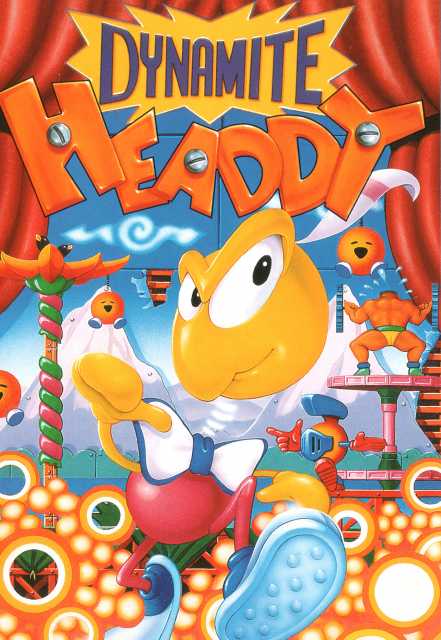Dynamite Headdy: An Underappreciated Treasure Classic
Dynamite Headdy is a Treasure developed 16-bit platformer, originally released for the Sega Genesis in 1994.
It's bizarre to think about a time when the platformer was the dominant genre, to have any chance of being successful developers looked to what was at the top, and at the time in question Sonic and Mario were the undisputed flagship franchises for their respective consoles, and so a plethora of mascot based side-scrolling platformers soon followed. Amidst this plethora of titles in what was an already very overcrowded genre it serves as a testament to the game itself that it manages to strike out and establish itself, with its technically sound game-play and visual design exhibiting flourishes of great charm and wild imagination. Unfortunately this was not enough to inspire sales at its time of release despite it becoming something of a critical darling, hardly surprising though when you consider the aforementioned competition.
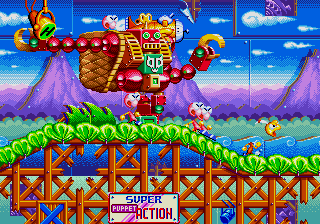
In the game you assume the role of the Titular hero, Headdy, A puppet in a stage show who may very well about to undergo the worst day of his life when Demon Damon, a dictatorial and shadowy figure suddenly appears and assumes control for himself, literally stealing the show in the process. With this Headdy has to make his through various stages (In more ways than one) in a quest to win over evil, this isn't helped by the seemingly endless supply of troops after him as well as cast of increasingly crazy puppets all bent on the same goal.
This is a game which certainly has the hallmarks of a 16-bit era Treasure game, it's crazy, addictive, colourful and above all difficult, for those unfamiliar with this approach it could come as something of a shock. It is a side-scrolling action game but describing it in such plain terms does the game as disservice, it is filled with Japanese quirk and style which is instantly appealing, and does a great deal in setting it apart.
Graphically Dynamite Headdy is a stand-out, it really utilizes the full power of the Genesis and cuts no corners in creating its hugely colourful world. The art style is where much of the originality and look of the game stems from but the animation of the characters particularly Headdy himself with his detachable body and various gesticulations help to cement the style and give it life. Visually it is definitely one of the best that the console has to offer.
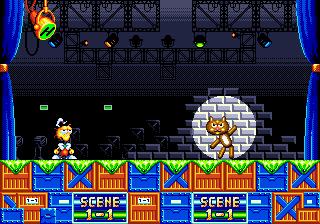
The element of a stage show is a concept which the game fully embraces, each stage is broken up into acts, this allows for the appearance to differ greatly from each as you progress from one set to the next. The screen is never dull as your senses are overloaded at every turn, the stages are bright and vibrant and numerous details adorn the landscapes. These details range from workers and stagehands who can be spotted going about their tasks in the background to instances where the sets themselves are falling apart, Headdy's health itself is even signified by a stage-light. These little touches all add up to help make Headdy's world a hugely interesting one, with something always around to catch the eye. Its this sense of fun and underlying humour that really lends to the charm of the game, one of the stand out moments being an encounter that takes place entirely backstage after you are dragged off the set of the previous level.
As a puppet Headdy lives up to his namesake, throughout his adventure he has access to various props in the form of different heads (there being 15 in all), these can range from powerful attack forms such as the Hammerhead to completely passive abilities such as Head trip which is a huge overweight Steel weight that renders the user unable to do anything for a limited time. For the most part each of the power-up’s has its own advantages and knowing when to use them can be the difference between success and failure, this is often put to the test in most boss battles where a selection are often at the players disposable with not all of them always being useful.
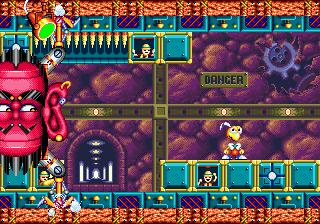
Most levels follow a traditional structure but there are occasions when things are mixed-up, such as a level where the axis is constantly shifting and where movement is essential to avoid falling into the abyss, others employ forced scrolling (one instant being the games most difficult section) whilst some give Headdy unique flying power-ups to play with. The talk of variety is not to say that the game doesn't do the bread and butter gameplay well, in fact Treasure had reached a level of refinement with their controls in Headdy, which is just as well because the game is often unforgiving. Bosses follow the firmly established formula of pattern based attacks that are a hallmark of previous Treasure games, if this fact needed to be driven home further a few bosses are extremely reminiscent of those found in one of their earlier titles Gunstar Heroes.
The sound is also worth mentioning. The music itself is ridiculously catchy and infectious and there are a couple of tunes that are bound to stay with you for some time, there are a few that seem misplaced in certain areas but overall the right tone is established with the majority of the pieces. The sound effects should be familiar to any Treasure fans, they have a tendency to re-use many of their trademark sounds and here is no different, to the familiar explosions down to the heavy thuds of machinery. Notably the game also contains some examples of voice samples which surprisingly are clear, which for obvious hardware limitations was a rarity at the time.
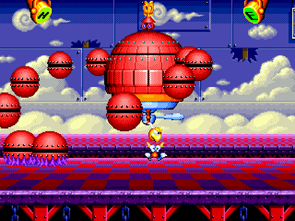
Any review of Dynamite Headdy wouldn't be complete without making mention of the numerous changes it underwent before leaving Japan, most of these are entirely aesthetic so its curious as to why cuts where actually made to begin with. The changes in question mainly concern the appearance of a couple of bosses with the most notable of these being the reoccurring character Trouble Bruin (Maruyama in Japan) but perhaps the most significant and noticeable change within the game is the increase in difficulty. In all versions outside of Japan the difficulty increase is present, in gameplay this makes the bosses themselves much more formidable. This is something which is detrimental to the player as here there are no continues whereas in the original the game presented you with two by default. After each boss a small window is granted for the player to grab enough collectibles to earn a continue, but this is not easy and is something which isn't made clear to the player to begin with. This is something which seems needlessly harsh in what was already a difficult and fairly lengthy game. However considering this is a Treasure game a difficulty curve such as this is nothing new.
Dynamite Headdy is a game I would definitely recommend that anyone with even a passing curiosity in this particular era of games. Its a Chaotic and at times frustrating game, but it offers up so much originality and off brand craziness not to mention great platforming gameplay that the niggles are only minor all things considered.
